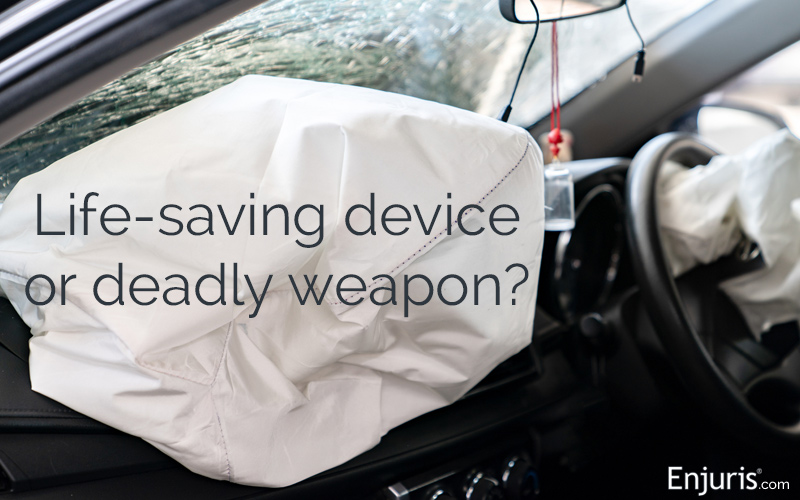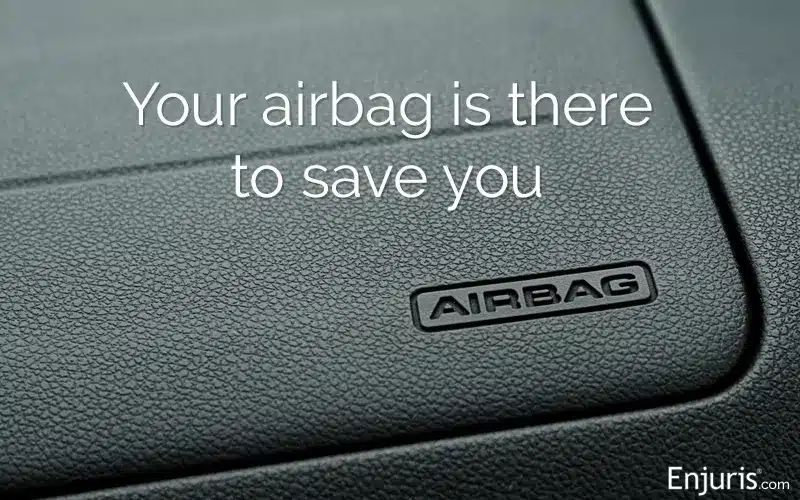
Can you sue a manufacturer if the airbag in your vehicle is unsafe?
Front airbags have been required in all vehicles in the United States since 1999, and many vehicles are equipped with optional side airbags.
The purpose of an airbag is to reduce occupant injury in the event of a crash by reducing the speed of impact, softening the blow, and spreading the impact over a larger area of the body.
Unfortunately, products—including airbags—don’t always perform as intended.
So what happens if your airbags end up doing more harm than good?
How do airbags work?
Airbags rely on the physics of a crash to work effectively.
As Popular Science explains:
“In the case of a head-on collision, a car usually stops fast. The body of the driver, of course, doesn’t. Its momentum continues until an outside force brings it to a stop. An airbag doesn’t just soften the blow. It actually lowers the impact by stretching it out over a longer period of time. That’s why airbags inflate and then quickly deflate—to gradually bring the driver’s momentum from 60 mph to 0.”
But how does an airbag actually deploy?
When your vehicle collides with something solid, a sensor (called an “accelerometer”) triggers a circuit that fires off an electrical current. The current ignites a charge that explodes. The explosion produces nitrogen gas, which fills the deflated airbag (packed into your steering column, dashboard, or car door) at about 200 miles per hour.
The whole process, from the time the sensor detects the collision to the time the airbag is fully inflated, takes only 30 milliseconds (0.03 second).
Common airbag deployment injuries
Experts agree that airbags are very effective in saving lives, but the speed at which an airbag deploys can cause injuries. Common airbag deployment injuries include:
- Facial trauma
- Orbital fractures
- Retinal detachment
- Rib fractures
- Friction burns and abrasions
- Cervical spine fractures
A review of U.S. National Highway Traffic Safety Administration (NHTSA) data from a 14-year period found that there were 618 airbag-related injuries in the U.S. Of these injuries, 42% affected the face, 33% affected the upper limbs, and 9.6% affected the chest. The most important finding, however, was that 96% of the injuries were classified as minor.
Generally speaking, children ages 0-12 seated in the front seat of a vehicle with an airbag and restrained by a seat belt are more likely to be killed in a crash than if they’re restrained by a seat belt but there’s no airbag present. This is one reason why most states don’t allow children to ride in the front seat.
Even if your state allows children to ride in the front seat, the American Academy of Pediatrics (AAP) recommends that all children ages 13 and under buckle up in the back seat. If an adolescent over age 13 is small for their age, it’s recommended that they sit in the back seat as well.
Can I file a lawsuit if I suffered an airbag injury?
If your airbag worked properly and you suffered a minor injury, you generally can’t sue for damages. This is because the airbag likely prevented you from suffering a more serious injury.
To recover damages for an airbag injury, you have to prove that the airbag was somehow defective—for example, the airbag failed to deploy when it should have or the airbag deployed when it shouldn’t have.
There are 3 types of airbag defects that may give rise to liability:
- Manufacturing defect. A defectively manufactured airbag is one that—though properly designed—left the manufacturer in a condition other than intended.
- Design defect. An airbag is defectively designed if it fails to perform as safely as a reasonable person would expect.
- Failure to warn defect. Airbag manufacturers have a duty to warn users of the dangers that can be reasonably anticipated and that are inherent in their airbags.
Adam filed a product liability lawsuit in Minnesota state court. Ford argued that the lawsuit should be dismissed because it was filed in the state where the accident occurred, rather than the state where the vehicle was manufactured. The issue made its way to the United States Supreme Court where the justices ruled against Ford.
The lawsuit is currently pending in Minnesota state court.
What damages can I recover in an airbag injury lawsuit?
In most cases, occupants injured by a defective airbag can recover the following damages:
- Economic damages represent the monetary losses caused by your injury (for example, medical expenses and lost wages).
- Non-economic damages represent the non-monetary losses caused by your injury (for example, pain and suffering and loss of consortium).
- Punitive damages are intended to punish the defendant. In cases where the defendant’s acts are particularly egregious, some states allow you to recover punitive damages.
Takata airbag recall and lawsuits
The Takata Corporation is responsible for the largest auto recall in American history. Since 2013, approximately 67 million Takata airbags have been recalled. The defective airbags have caused at least 18 deaths and more than 180 injuries in the U.S.
What went wrong?
As discussed earlier in this article, most airbags inflate when nitrogen gas fills the deflated airbag. However, Takata airbags used ammonium nitrate to inflate the airbags. Ammonium nitrate can break down and become unstable when exposed to moisture. This isn’t necessarily a problem if the ammonium nitrate contains a chemical drying agent.
Unfortunately, the Takata airbags at issue did not contain a chemical drying agent. As a result, unstable ammonium nitrate caused an explosion in some vehicles, which caused the airbags to improperly inflate and sent metal shrapnel hurtling through the vehicles.
- Check for recalls using your vehicle identification number (VIN)
- Bring your vehicle to your local dealer (the airbags will be repaired or replaced for free)
- Sign up for recall alerts about any future recall affecting your vehicle
A number of individual lawsuits and class action lawsuits have been filed against Takata in an attempt to receive compensation. Lawsuits have also been filed against some automakers, alleging that the automakers knew that Takata’s airbags were dangerous but continued to use those airbags in their vehicles to save on costs.
How do I find an airbag injury lawyer?
If you or a loved one has been injured by an airbag, it’s important to reach out to a product liability lawyer as soon as possible. Most initial consultations are free.
To find a lawyer, we invite you to use Enjuris’ free online directory of personal injury and product liability attorneys near you.
Toyota Recalls Airbag Sensors Over Safety Risk
Toyota has recalled more than a million vehicles because of a faulty sensor in the airbags. But can a consumer still have legal recourse for an injury?
See our guide Choosing a personal injury attorney.

